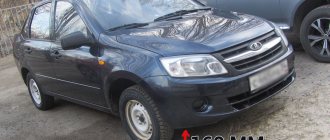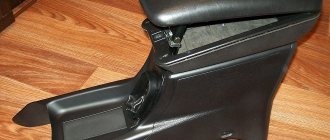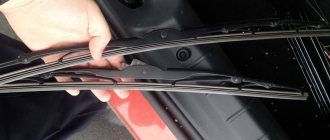Ground clearance is the distance from the ground to the lowest point of the center of the car. The vehicle's cross-country ability and stability on the highway depend on this characteristic. Do you know what ground clearance Vesta has, and how much it differs from the ground clearance of other modern Lada cars?
Ground clearance
The main and biggest plus of the Russian cross-sedan is its high ground clearance. According to factory specifications, its height is 203 mm. Not every modern crossover can boast the same. High ground clearance is needed if you at least sometimes drive off smooth asphalt. However, it is also useful in big cities with their eternal construction sites, speed bumps and curbs that do not comply with GOST. Now remember how they like to raise the suspension, including on sedans, in the provinces. So, Vesta Cross is definitely in trend.
The Lada Vesta Cross has such ground clearance that even crossovers can envy. And the overhangs are moderate. So the geometric cross-country ability is very good.
The Lada Vesta Cross has such ground clearance that even crossovers can envy. And the overhangs are moderate. So the geometric cross-country ability is very good.
Ground clearance Lada Vesta Cross
But, in the Cross version, Lada Vesta went even further. By designing this model, engineers tried to satisfy the needs of the most meticulous and demanding customers, and give them the opportunity to use Vesta in very extreme conditions.
The Lada Vesta Cross has the characteristics of a full-fledged crossover, and has a ground clearance of as much as 203 mm , which allows it to be used on dirt roads and rough terrain. This is, of course, not a full-fledged SUV, but it is the best option for hunting or fishing enthusiasts who permanently live in the city.
Naturally, when going outdoors, the car is usually loaded “to its fullest”, therefore, in such a situation you need to be prepared for the ground clearance to decrease by a couple of centimeters. For such cases, engineers have provided the ability to increase ground clearance using special spacers that are attached to the car's shock absorbers.
But, do not forget that, as in other models, in Vesta Cross, after installing spacers, the driving characteristics of the car will change. It will become less stable when cornering, ride comfort will change, and its maneuverability will deteriorate.
Thanks to its ground clearance, which is higher than in some foreign cars of this class, the Lada Vesta Cross has acquired good competitiveness and is being bought up by car enthusiasts very actively.
Design
The second noticeable plus is the appearance of the car. Even the ordinary Lada Vesta still arouses interest in many regions. What can we say about a car with increased ground clearance, on 17-inch wheels, with a plastic body kit on the bottom of a bright red body (optional color “Mars”)! No tuning needed. The interior of the Cross is also more elegant than in the regular Vesta, with numerous orange inserts. The “cross” Lada series is also characterized by orange instrument scales. Even if you choose any other of 10 body colors (for example, gray) and gray inserts in the interior, Vesta Cross will still attract attention. Many people find this flattering.
The interior of this car will not let you forget about its pseudo-off-road features. Although psychologists may say that this color combination is too aggressive.
The interior of this car will not let you forget about its pseudo-off-road features. Although psychologists may say that this color combination is too aggressive.
Comparison with other domestic options
Vesta's ground clearance up to the stiffener.
Vesta surpasses all of its one-line brothers and sisters. The only exceptions are all-wheel drive models with all-terrain capabilities.
Even they are inferior to our record holder if presented in a hatchback version. The difference is small, but present. It turns out that only Kalina 2 and Largus with all-wheel drive have a little more ground clearance.
A worthy candidate for this class is the Nissan Almera, which has a 165 mm distance from the pan to the ground. Just like Vesta on fifteen-inch wheels. But another Datsun on-DO sedan has 174 millimeters, being a record holder in this area.
Even more happens only in those cars that have a higher class. For example, the Peugeot 408 illuminates the road by as much as 178 millimeters from the ground to the crankcase. He sort of set a world record.
Three-volume body
Lovers of sedans, of which we have a surprising number, explain their choice by the fact that in a car with a trunk separated from the passenger compartment, it is quieter, warmer and there are no foreign odors coming from the trunk. Each of these statements can be argued. But we can agree. The trunk volume of this sedan is the same as that of the station wagon (under the shelf) - 480 liters, and the rear seat back also folds in parts.
The volume of the luggage compartment is 480 liters. One “but”: when loading under the lid, you will have to take into account the hinges protruding into the trunk and place things so as not to crush them.
The volume of the luggage compartment is 480 liters. One “but”: when loading under the lid, you will have to take into account the hinges protruding into the trunk and place things so as not to crush them.
The sedan is also lighter than the station wagon (by 50 kg). And the body is stiffer. This entails better handling. Most likely, the interior will begin to creak later than in the station wagon. However, particularly large items (for example, a packaged washing machine or a kitchen stove) cannot be transported in a sedan. But in a station wagon you can at least try. But this is so, a remark.
Increasing lumen in simple words
It is recommended to install spacers. It should be remembered that this operation violates the factory parameters of the chassis. How the suspension will behave and how much such design changes will affect the geometry of the body, including subsequent safety, is unknown.
There are drivers for whom the factory interval sizes do not inspire confidence. There are ways to lift a car. The rear section is raised using a spacer. These are metal plates installed under the struts on top of the spring. Installation by a professional driver takes about half an hour. Due to this method, the gap to the ground increases by three centimeters (cm).
When fixing from the front, difficulties will arise, since the front is heavier and it is inconvenient to crawl up. For this they also buy spacers, but different ones.
Technically, it is possible to increase ground clearance on any car; it is necessary to consider the feasibility of such an undertaking. The easiest way is to install larger diameter tires instead of standard ones. The model under consideration has the ability to install tires with a width from 195 to 215 mm, coupled with replacing discs according to the formula: “lower tires - larger disc diameter, and vice versa,” which is not recommended by the manufacturer. Moreover, installing disks of R16 size is not allowed.
The next option is to replace the standard shock absorber springs. Springs with a larger number of turns are installed. You will also have to change the shock absorbers themselves. This kind of tuning will make the suspension stiffer, but it was a little stiff from the start. The decision is up to the owner; there is no universal recipe.
Such reconstruction is subject to the law on changes in the design of transport; difficulties may arise during the sale. But this is rare.
Unification
The fourth plus is unification. In most parts, components, and body panels, the Cross is identical to the regular Vesta, and in some (body kit, interior) it is identical to the SW Cross station wagon. The suspension is also the same, with the exception of slightly shorter rear springs, which carry less load compared to “universal” springs. By the way, the sedan is more comfortable than the station wagon, not only because it is stiffer and quieter, but also because it is less sensitive to road irregularities.
The car is as unified as possible with other models of the family. It will not be difficult to find spare parts for it, and mechanics will easily cope with any malfunction.
The car is as unified as possible with other models of the family. It will not be difficult to find spare parts for it, and mechanics will easily cope with any malfunction.
Ground clearance with CVT
AvtoVAZ employees proudly note that the CVT has not reduced the ground clearance, but there is a certain amount of deceit in this. When we talk about ground clearance of 178 mm for the basic sedan and station wagon and 203 mm for cross-country versions, we mean the measurement under the engine crankcase. The variator hangs below the engine crankcase by 22–23 mm.
. Writes the portal drom.ru.
| Vesta | XRAY | Granta | Kalina | Kalina Cross | Largus | Largus Cross | Priora | |
| Ground clearance, mm | 187-190 | 190 | 205 | 195 | 205 | 175 | 195 | 170-187 |
By the way, ground clearance also depends on the wheels and tires. Let us remind you that another issue that worries buyers is the quality of sound insulation of Vesta.
Keywords: front suspension Lada Vesta | Lada Vesta rear suspension
Found an error? Select it and press Ctrl Enter..
- What will the new generation of Lada Granta be and when will it be released, new details
- The main pros and cons of Lada Priora, identified by a survey among owners
- How to flash MMC Lada Vesta using an SD card
- Installation of internal rear door handles on Lada Largus
What's wrong with the Lada Vesta Cross?
And now the features of the Lada Vesta Cross that you need to get used to. And the first of them is just the price range, from 763,900 to 859,900 rubles. It’s hard to come to terms with the idea that a Russian car, even the latest one, costs the same as a foreign car. However, this is true. At the same time, Vesta Cross is more expensive than a regular Vesta sedan in a similar configuration by 53,000 (with a 1.8 engine) or 63,000 rubles (with a 1.6 engine).
Theoretically, Lada Vesta Cross, as well as SW Cross, can be equipped with all-wheel drive. But then the price of the car will exceed a million. And who will buy it?
Theoretically, Lada Vesta Cross, as well as SW Cross, can be equipped with all-wheel drive. But then the price of the car will exceed a million. And who will buy it?
By the way, the ground clearance of the standard Lada Vesta is 178 mm and can be even higher with 17-inch wheels. And no one forbids you to install steel protection, like on the Cross. What else remains? Plastic body kit on the bottom? If you drive carefully, you can do without it. Red inserts in the interior and orange dials? Everything can be done if there is a desire.
A sedan with increased ground clearance? Why not - if this is the work of automakers, and not home-grown tuners?
A sedan with increased ground clearance? Why not - if this is the work of automakers, and not home-grown tuners?
And the second feature is the uniqueness of the car. Only Volvo has a similar car, a lifted sedan. This is the S60 Cross Country. But it costs from 2.5 million rubles, has been produced for a long time and is not particularly popular in Europe. Lada Vesta Cross can completely occupy a vacant niche.
Lada Vesta Cross: 5 advantages and 2 features that you need to get used to
↑ Determination of clearance
First, it’s worth understanding what the clearance of the Lada Vesta is. We are talking about ground clearance, that is, the distance from the surface of the earth to the lowest protruding point of the car. Since the vehicle is produced in Russia, the condition of the roads in the country was taken into account during its development. Thanks to this, the car turned out to be quite tall. But it’s worth figuring out what indicators relate to the car.
Specifications
| Modifications | 1.6 l 106 hp (gasoline) manual transmission | 1.8 l 122 hp (gasoline) manual transmission | 1.8 l 122 hp (petrol) AMT |
Are common | |||
| Production year: | 2019 — | ||
| Brand country | Russia | ||
| Country of assembly | Russia | ||
| Number of places | 5 | ||
| type of drive | Front | Front | Front |
| Guarantee | 3 years or 100,000 km | ||
Dynamic characteristics: | |||
| Acceleration to 100 km/h | 12,3 | 11,2 | 13,3 |
| Maximum speed | 178 | 180 | 180 |
| Ground clearance | 203 | 203 | 203 |
Fuel consumption (l): | |||
| City | 9,7 | 10,7 | 10,1 |
| Route | 6 | 6,4 | 6,3 |
| Average | 7,5 | 7,9 | 7,7 |
Motor | |||
| Motor type | Petrol | Petrol | Petrol |
| Brand | VAZ-21129 | VAZ-21179 | VAZ-21179 |
| Power | 106 | 122 | 122 |
| Torque Hm | 148 | 170 | 170 |
| Compression ratio | — | ||
| Fuel used | AI-92 | AI-92 | AI-92 |
| Boost type | — | — | — |
Dimensions and weight | |||
| Length mm | 4424 | 4424 | 4424 |
| Width mm | 1785 | 1785 | 1785 |
| Height mm | 1532 | 1532 | 1532 |
| Wheelbase mm | 2635 | 2635 | 2635 |
| Tank volume, liters | 55 | 55 | 55 |
| Trunk volume, liters | 480 (825) | 480 (825) | 480 (825) |
| Vehicle weight, kg | 1280 | 1280 | 1300 |
Ground clearance of Lada Vesta A description of the concept of a full load is necessary to measure the distance from the bottom of the car to the ground. To find it, the masses of the car itself, the driver, passengers and the transported cargo are summed up. All this adds about 400 kg to the suspension.
- according to the stated data, when fully loaded, the ground clearance of the Lada Vesta will be 171 mm under the engine crankcase (the largest hollow part, statically mounted on the engine block);
- ground clearance of the Lada Vesta under the engine splash guard, which protects the engine compartment from dirt and dust, also when the passenger compartment and trunk are full – 144 mm;
- without load, the following figures can be observed: 190 and 230 mm, under the crankcase and with the weight of the bumper, respectively.
As measurements show, the Lada Vesta is inferior in ground clearance to all previous models of the Tolyatti plant. The sedan turned out to be a fairly tall car, and the ground clearance indicators are normal for AvtoVAZ itself, which designs cars taking into account the realities on domestic roads.










